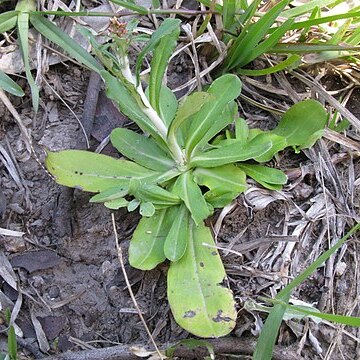Winter annuals or biennials, 15–35(–50) cm; fibrous-rooted. Stems decumbent-ascending, white-pannose (tomentum usually sheath-like). Leaves basal and cauline, basal present (in rosettes) at flowering, blades spatulate to oblanceolate-obovate, (1.5–)3–8(–12) cm × 6–15(–22) mm (gradually or little smaller distally, slightly succulent, margins often crenulate on drying), faces bicolor, abaxial closely white-pannose, adaxial glabrous or glabrate. Heads initially usually in dense, continuous spiciform arrays 2–20 cm × 10–14 mm (pressed), later branched, interrupted. Involucres cylindro-campanulate, 2.5–3 mm, bases glabrous. Phyllaries in 4–5 series, outer (purplish or rosy) elliptic-obovate to broadly ovate-elliptic, lengths 1/3–1/4 inner, apices rounded to obtuse, inner oblong, laminae brown-hyaline, apices rounded to obtuse or blunt, apiculate. Florets: bisexual 2–3; all corollas usually purplish distally. Cypselae (tan) 0.5–0.6 mm. 2n = 28, 40.
Annual or biennial herb with a basal leaf rosette and several radiating usually strongly decumbent lateral leafy flowering branches up to 500 mm tall. Leaves up to 120 x 20 mm, narrowly spathulate, becoming progressively smaller upwards and passing into inflorescence bracts, markedly discolorous, green and glabrescent above (often drying brown), white-felted below. Heads c. 4 x 2 mm, oblong, in small glomerules or spikes arranged in a long racemose inflorescence. Involucral bracts in c. 3 series, innermost about equalling the flowers, pellucid, tips reddish purple at first, later golden-brown. Flowers c. 80-100 ('female'), 2-30, whitish, tipped reddish purple. Achenes c. 0.5 mm long, minutely hairy, myxogenic. Pappus bristles many, scabrid, bases fused in a smooth ring.
Annual or biennial herb, up to 500 mm high. Leaves in a basal rosette, narrowly spathu-late, cauline leaves smaller, entire, markedly discolorous, upper surface glabrescent, lower surface white-tomentose. Capitula disciform, in small glomerules or spikes arranged in long racemose inflorescence; involucral bracts in ± 3 rows, apex reddish purple at first turning golden-brown. Female florets filiform, outnumbering disc florets, whitish, tipped reddish purple. Disc florets bisexual, whitish, tipped reddish purple. Flowering time Oct.-Jan. Pappus of many barbellate bristles in 1 row, bases fused in a smooth ring. Cypselae small, oblong, minutely hairy.
Annual or biennial herb, up to 500 mm tall. Leaves markedly discolorous, upper surface glabrescent, lower white tomentose, in a basal rosette; cauline leaves smaller. Heads in small glomerules or spikes arranged in long racemose inflorescence. Flowers whitish, tipped reddish purple.

